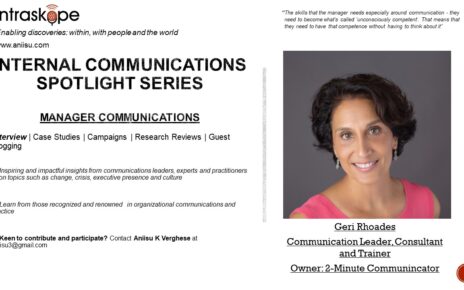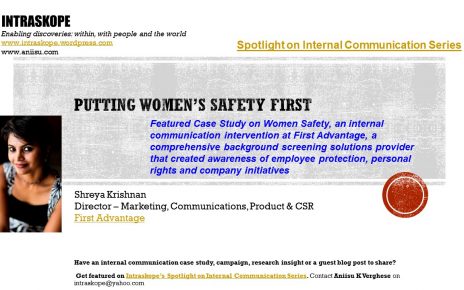Presenting the 43rd edition of Intraskope’s Spotlight on Internal Communication Series featuring Vinitha Oommen of Northern Trust. Vinitha is an advocate of brand building and storytelling and has over 19 years of experience with internal communication, social media marketing, analysts relations, global public relations, events, employee engagement and corporate social responsibility. Watch the complete video interview on YouTube or read the transcript below.
Interview
- What does internal communication mean to you?
Communication can be verbal, non-verbal, oral or written. In this sense, Communication to me is the sum of all the efforts we take to create and deliver important information or an experience.
2. How is it practiced in your organization?
As in every organization, internal communication is an integral part of our organization. It is designed to inform, inspire, influence and engage our stakeholders, including our employees and clients. We have a central alignment to our parent organization that allows us to stay the course in terms of consistent messaging, delivery of strategic initiatives, etc., with a dash of localization to customize the experience.
3. Please share an example/campaign that you are personally proud of working on and that made a significant impact to your organization in the recent past
This takes me back to my Mu Sigma days. In a start-up environment, we were always looking at ways to permeate the organization culture and values amongst employees. Two such aspects of the organization were being nimble and agile, with a pivot around improving productivity. And so we laid out an employee engagement event in a campaign-like fashion, inspired by FedEx – One Team, One Idea and One Day. For promotion, we augmented email blasts with danglers in the facility, interesting skits, and sponsorship from leadership. All these activities tied into the key message/themes of delivering services and solutions that enhance stakeholder experience and creates lifetime value. What makes me proud of this event is the fact that we used blended communications methods – digital, online and on-ground; we leveraged leadership to spread the word, and we had employees engaged in creating a greater organization.
4. What is the biggest challenge you face while going about managing internal communication?
One of the challenges that I believe I and the larger community of communicators face is when everyone seems to believe that they know and understand communications. Communications in a corporate environment is way beyond speaking and writing grammatically correct. It is deeper. It is about being sensitive and cognizant of the various objectives and information needs and delivering them in context, with relevance, in an optimized manner, and with clear actions to create an impact. The way to address this challenge, and which I absolutely believe in is asking questions: WHY are we communicating (the purpose), WHAT is it that we want to achieve (the impact/ feedback/ outcome) and HOW do we go about making it happen (the channels, the resources, etc.). Don’t shy away from repurposing and sharing best practices from peers in the industry – it prevents reinventing the wheel!
5. What according to you is the biggest opportunity that internal communicators have?
Opportunities for internal communications are ample. However, one of the biggest opportunities that distinctly exists is the ability to take it from a Business as Usual function to a more “Seat at the Table” function – to move the needle beyond transactional to strategic, with measurable outcomes. What this entails is to look at Internal Communications through the lens of a marketer, a sales representative, a client, an end user, etc. Because, come to think of it your existing stakeholders are the biggest ambassadors you have. If each person in this range understands what you’re trying to achieve that may impact their decisions or actions, then as a communicator we’ve succeeded in “building the experience inside-out”. Marketing can then leverage their role of bringing the brand outside-in (your media presence, earned mentions, awards, marketing qualified leads, etc.).
6. How can internal communicators add more value to the business?
Align internal communication to be authentic and be the ombudsman between the management and internal stakeholders. Basically, point to remember is that internal communication is branding inside out, just as marketing is about branding outside in. In both, one factor that needs to remain constant is the way we position the brand. Employees are an organization’s greatest brand ambassadors and your communications should be honest, transparent, and relevant; it must resonate with them at a personal level too. Deliver to your organizations’ employee value preposition, while also enhancing user experience, connectivity and pride in association in tandem.
7. What skills must they have or develop?
Some skills that work well given that we live in a digitally enhanced, shorter attention span environment and VUCA world at that are:
Ability to ask questions – This is important to clarify and take necessary next steps.
Being cognizant of your audience and their situation – one size does not fit all
Learn the basics of content optimizations – It’s a race against time and competition, so you better make your content count.
Be clear – no one has the time to read lengthy literature.
Build an appreciation for other associated areas of communications – marketing communication, sales enablement, employer branding, media relations, campus relations, etc. You need to be able to connect the dots in order to deliver that perfect pitch/ “experience” as a communicator!
Earn the reputation – Put every effort to ensure employees feel welcome and included; stay authentic.
8. What is your advice for people who are keen to join internal communication and make a career?
I’d say, go for it! But remember to be mindful and inclusive in your approach. Be a continuous learner– our environment is very dynamic. Arm yourself with the right skillset, toolset and mindset to ensure you are able to connect the dots.
9. With COVID-19 and other crises, how must internal communications engage? What has changed or will change?
Today, we have people who are more aware, more connected (having an almost influencer-like status among their circle), with lesser tolerance to things not acceptable – they have a voice. Add to this all the digital disruption we are witnessing with information at your fingertips. This landscape has changed the way we look at communication all round.
When you think of “crisis”, multiple “emotions” comes to play – apprehensions, anxiety, unpredictability, the need for assurance, etc. The role of internal communications magnifies 10-fold in such a situation. Here are the five key facets that I believe need to be considered in a crisis:
Set up a water-tight task force to evaluate, execute and control next steps – The taskforce must be one that has representation across the enablement and fulfilment functions, with clear roles and responsibilities carved out, and must meet as frequently as the situation demands – on-call. Communications must have a representation in this group. It must be an “all hands on the deck” approach.
Initiate internal pulse checks (keep it periodic) – This will be useful to glean insights, tone the message in a way that matter to our internal stakeholders, and provide leadership a view of employee sentiment in real-time. Keep an open channel for employees to share/ address their grievances/ concerns.
Be diverse in your thinking and inclusive in your approach – Empathy will be the core of communications designed during a crisis. An understanding that there is a spillage effect on employees and that each employee has a different setup will be helpful when handling a crisis communication.
Ensure leadership presence – This will be essential. Leadership presence and assurance in times of crisis is the most valuable engagement; it goes a long way in not just building a resilient organization in a crisis situation, but also an environment where employees feel safe and cared for – it is a sense of security.
Weigh in on the magnitude of the situation versus its impact to the organization and hence internal stakeholders –The way internal communication responds to an individual crisis within an organization versus a situation like the pandemic could vary in approach and scale. Understanding the situation versus the impact can help define the approach you want to take – should the communication go to a focused group (the impacted person, the team or the entire organization), does this call for a full-fledged task force or just the involvement of the respective fulfilment and HR teams, must the communication be for awareness or should we require any action from impacted employees, etc.
10. If there is one aspect of internal communications you would like to change, what would that be?
Go beyond language. Look at communications more holistically; after all your stakeholders of today are your reputation manager of tomorrow. The better their experience, then higher the chances for them to recommend the brand to others. Brand affinity is built on authenticity and earned credibility.
Liked the interview? Post your comments and share it with your network.
Keen to contribute and participate in the ongoing series on Intraskope where we put the spotlight on thought leadership, great ideas, and practical solutions? Look up the previous stories from organizations featured on the Intraskope’s Spotlight on Internal Communication Series here – AXA Business Services, Subex, global insurer, Standard Chartered Bank, BASF, Applied Materials India, Microsoft UK, Times Group, Samsung, Falabella, Cisco, Brillio, UAE Exchange, Apeland, M.H. Alshaya Co, Proctor & Gamble, Infosys, SOBHA Ltd., ICICI Securities, First Advantage, CK Birla Group, TVS Motors, GE, Suzlon, Tata Sons, Percept, Knight Frank, TCS Europe, Vedanta, Oxfam, Danske Bank, Diageo, Pandora, Symantec, ISS Global Services, Telia, Thomson Reuters, IBM, General Motors, Intelligence India Software Solutions, Philips and Refinitiv.
Intraskope (www.aniisu.com) is the first blog on internal communications in India and among the earliest around the globe. Begun in 2006, the blog has over 1000 posts on topics such as employee engagement, leadership communication and employee branding and receives thousands of visits from across the world. The blog, receives over 1,50,000 visits every month from over 50 countries globally, offers learning resources for practitioners, academicians, and students including industry workshops, research reports, and checklists.
Intraskope has been featured on leading global internal communication forums like Simply-Communicate, IC Kollectif and International Association of Business Communicators. It is hosted by Aniisu K Verghese, author of Internal Communications – Insights, Practices & Models (Sage, 2012).
If you are an internal communication leader working in a firm or a not-for-profit anywhere in the world and have an internal communication case study, campaign, research insight or a guest blog post to share please contact me on [email protected]
Here are Internal Communications resources you can use:
• Internal Communications Series: https://forms.gle/KcqmPzLwq7NQi5Km6
• Chat with Aniisu – Internal Communications: https://www.instamojo.com/intraskope/connect-with-aniisu-60-minute-personalized-d/?ref=store
• Internal Communications workshops: https://bit.ly/2zdBRl1
You can also visit my website www.intraskope.com and You Tube channel to know more about my work.


